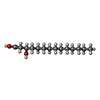+ Open data
Open data
- Basic information
Basic information
| Entry | Database: PDB / ID: 8s4l | ||||||
|---|---|---|---|---|---|---|---|
| Title | NMR structure of orfamide A in micellar DPC solution | ||||||
 Components Components | orfamide A | ||||||
 Keywords Keywords | SURFACTANT PROTEIN / Non-ribosomal polipeptide / Cyclic lipodepsipe / Antimicrobial peptide / Biosurfactant | ||||||
| Function / homology | : / 3-HYDROXY-TETRADECANOIC ACID / polypeptide(D) Function and homology information Function and homology information | ||||||
| Biological species |  Pseudomonas protegens (bacteria) Pseudomonas protegens (bacteria) | ||||||
| Method | SOLUTION NMR / molecular dynamics | ||||||
 Authors Authors | Kovacs, B. / Geudens, N. / Martins, J.C. | ||||||
| Funding support |  Belgium, 1items Belgium, 1items
| ||||||
 Citation Citation |  Journal: To be published Journal: To be publishedTitle: NMR structure of orfamide A in micellar DPC solution Authors: Kovacs, B. / Geudens, N. / Martins, J.C. | ||||||
| History |
|
- Structure visualization
Structure visualization
| Structure viewer | Molecule:  Molmil Molmil Jmol/JSmol Jmol/JSmol |
|---|
- Downloads & links
Downloads & links
- Download
Download
| PDBx/mmCIF format |  8s4l.cif.gz 8s4l.cif.gz | 46.7 KB | Display |  PDBx/mmCIF format PDBx/mmCIF format |
|---|---|---|---|---|
| PDB format |  pdb8s4l.ent.gz pdb8s4l.ent.gz | 31.5 KB | Display |  PDB format PDB format |
| PDBx/mmJSON format |  8s4l.json.gz 8s4l.json.gz | Tree view |  PDBx/mmJSON format PDBx/mmJSON format | |
| Others |  Other downloads Other downloads |
-Validation report
| Arichive directory |  https://data.pdbj.org/pub/pdb/validation_reports/s4/8s4l https://data.pdbj.org/pub/pdb/validation_reports/s4/8s4l ftp://data.pdbj.org/pub/pdb/validation_reports/s4/8s4l ftp://data.pdbj.org/pub/pdb/validation_reports/s4/8s4l | HTTPS FTP |
|---|
-Related structure data
| Similar structure data | Similarity search - Function & homology  F&H Search F&H Search |
|---|---|
| Other databases |
|
- Links
Links
- Assembly
Assembly
| Deposited unit | 
| |||||||||
|---|---|---|---|---|---|---|---|---|---|---|
| 1 |
| |||||||||
| NMR ensembles |
|
- Components
Components
| #1: Polypeptide(D) | Type: Lipopeptide / Mass: 1087.308 Da / Num. of mol.: 1 / Source method: isolated from a natural source Details: 1) The polypeptide chain of orfamide A consists of 10 amino acids. 2) The N-terminal amino acid (DLE) is acylated with an (R)-3-hydroxy-tetradecanoic acid moeity (FTT) which is indicated as ...Details: 1) The polypeptide chain of orfamide A consists of 10 amino acids. 2) The N-terminal amino acid (DLE) is acylated with an (R)-3-hydroxy-tetradecanoic acid moeity (FTT) which is indicated as the first residue. 3) The depsi (ester) bond is established between the VAL11 carboxyl and 2TL4 side-chain OH group. 4) There are 2 amino acids with unusual side-chain configurations, D-allo-ILE5 (28J) and D-allo-THR4 (2TL4)., Cyclic lipopeptide Source: (natural)  Pseudomonas protegens (bacteria) / References: BIRD: PRD_002561 Pseudomonas protegens (bacteria) / References: BIRD: PRD_002561 |
|---|---|
| #2: Chemical | ChemComp-FTT / |
| Compound details | Cyclic lipopeptide with antifungal activity |
| Has ligand of interest | N |
| Has protein modification | Y |
-Experimental details
-Experiment
| Experiment | Method: SOLUTION NMR | ||||||||||||||||||||||||||||||
|---|---|---|---|---|---|---|---|---|---|---|---|---|---|---|---|---|---|---|---|---|---|---|---|---|---|---|---|---|---|---|---|
| NMR experiment |
|
- Sample preparation
Sample preparation
| Details | Type: solution Contents: 1.9 mM orfamide A, 111.9 mM [U-2H] DPC, 90% H2O/10% D2O Details: Orfamide A was dissolved in the micellar solution of uniformly deuterated dodecylphosphocoline (DPC-d38). Solvent: 10 mM Na2HPO4/NaH2PO4 buffer at pH 7.4. Label: 1H / Solvent system: 90% H2O/10% D2O | ||||||||||||
|---|---|---|---|---|---|---|---|---|---|---|---|---|---|
| Sample |
| ||||||||||||
| Sample conditions | Ionic strength: 26 (buffer only) mM / Label: conditions_1 / pH: 7.4 / Pressure: 1 atm / Temperature: 310 K |
-NMR measurement
| NMR spectrometer | Type: Bruker AVANCE II / Manufacturer: Bruker / Model: AVANCE II / Field strength: 700 MHz / Details: Prodigy Cryoprobe |
|---|
- Processing
Processing
| NMR software |
| ||||||||||||||||||||||||
|---|---|---|---|---|---|---|---|---|---|---|---|---|---|---|---|---|---|---|---|---|---|---|---|---|---|
| Refinement | Method: molecular dynamics / Software ordinal: 1 Details: The lowest energy NMR structure issued from CNS was refined using unrestrained AMBER molecular dynamics simulations (against the ff14SB force field). Here, we modelled the interaction of a ...Details: The lowest energy NMR structure issued from CNS was refined using unrestrained AMBER molecular dynamics simulations (against the ff14SB force field). Here, we modelled the interaction of a single peptide molecule with an explicit dodecylphosphocholine (DPC) micelle. The representative peptide conformation of the trajectory (=refined structure) was selected using cluster analysis. Solvent model: TIP3P | ||||||||||||||||||||||||
| NMR representative | Selection criteria: closest to the average | ||||||||||||||||||||||||
| NMR ensemble | Conformer selection criteria: structures with the lowest energy Conformers calculated total number: 100 / Conformers submitted total number: 11 |
 Movie
Movie Controller
Controller



 PDBj
PDBj


 HSQC
HSQC